Introduction
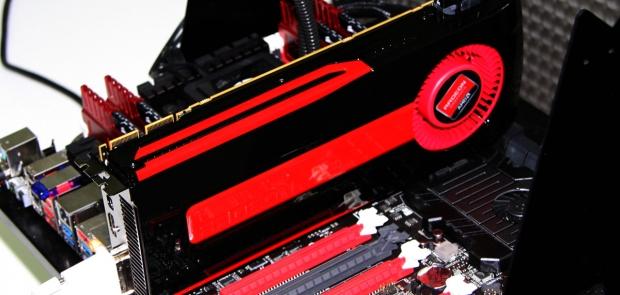
It unusual for us to miss an NDA, especially when we've got the sample on hand. The simple fact is that AMD chose to Grinch out on us and ignore the holiday spirit, a time when we tend to be able to relax for a few weeks before the CES run of products start to show up. With not only a 10 day holiday planned, but a decision to move from Perth, Australia to Taiwan just three months ago all in the works, the HD 7970 NDA was just one that wasn't going to be met, even though, our sample was sitting safely in Taiwan waiting for my arrival.
With a couple of samples built up over the last few weeks, the HD 7970 was straight on top and today we'll be finally checking out what the new model is all about. Unfortunately it wasn't just a matter of testing the HD 7970 and we could get on our way, along with that we tested a couple of other cards with the most recent drivers to see just what's going on with this new single GPU card from AMD.
Normally we'd move from here into the package of the card, but we're dealing with just a reference card here from AMD which means we of course don't have a bundle to look at, instead we'll be moving straight into the card and check out the main specifications of the new card from AMD.
Once we've done that we'll move into our testbed to see what's going on while we also take a look at the cards we'll be including in our graphs today. Then we get into the fun stuff and see what kind of performance the new single GPU card from AMD can put out before we wrap everything up. So with that all said and done let's check out the new card from AMD.
The Card & Specifications
The Card
Looking at the card head on we don't see anything too different to what we've seen in the past from AMD. We've got a fairly standard black and red setup going on with a fan placed towards the rear of the card which helps draw cool air in, push it across the GPU in the middle of the card and straight out the back of the case. Compared to the HD 6970, though, the fan is a little wider now and has been improved slightly to help push more air over the card, hopefully not at the cost of noise.
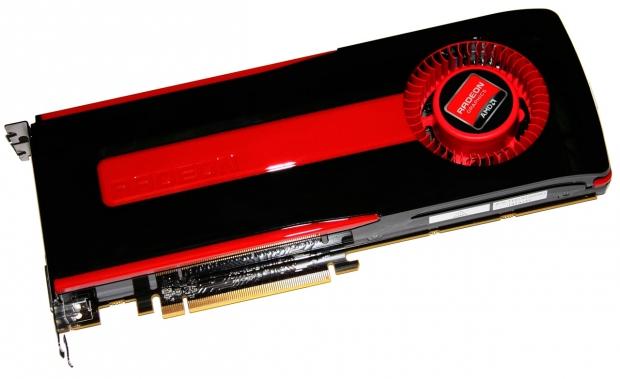
The fan design continues to be one of the strongest thanks to the way it pushes the air straight out the back of your case. It makes it an ideal solution for people who are going down the path of multiple cards. The biggest issue with the fan design has always been that it tends to carry higher noise levels when compared to some of the aftermarket cooling options. It will be interesting to hear what kind of numbers the new HD 7970 puts out when placed under load.
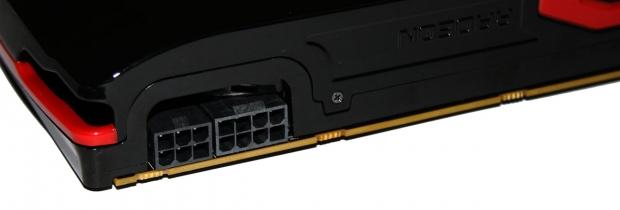
Making our way around the card we can see towards the back we've got a power setup which consists of the same setup we saw on the HD 6970; a single 8-Pin PCIe connector alongside a single 6-Pin PCIe connector. This is the typical setup we've seen out of high-end single GPU cards and we don't doubt we'll see in time companies like Sapphire and MSI offer us overclocked models which swap out the 6-Pin PCIe connector for a second 8-Pin one.

Moving closer to the front we can see our two CrossFire connectors which means we're able to run up to four of these cards together. No doubt in time we'll also be able to do configurations which include a single HD 7990 with one or two of these cards to make up three and four GPU configurations. Also here we can see just to the left we've got that little switch we saw pop up with the release of the HD 6900 series. Just like we could do previously, it gives us the ability to switch over to the unprotected mode and flash the BIOS of the card. If everything heads south, we can flick back over and go back to the default BIOS.
While a cool feature, it wasn't something that was really used on the HD 6970, instead we saw it used on the HD 6950. Early batches of the card saw the ability to flash a HD 6970 BIOS to the HD 6950 at what seemed to be with no risk. We also saw the switch used on the higher end dual GPU HD 6990 with the ability to switch between the stock speeds of the card and the overclocked ones that AMD offered via "AUSUM Mode".
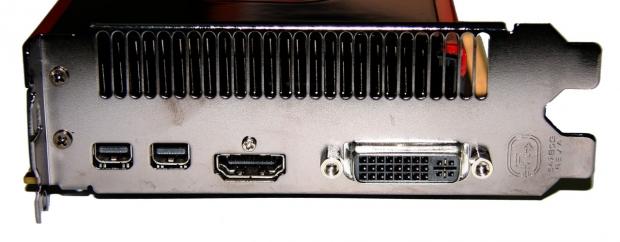
Moving to the IO side of things we can see what's going on with the connectivity of the card. Starting from the right we've got a Dual-Link DVI cable for all your ultra-high resolution 2560 x 1440 / 1600 screens along with full support for 120Hz monitors. Next to that we've got a full size HDMI 1.4a port which supports HD Audio and 3D support for Blu-ray movies and finally we end with two mini DisplayPort 1.2 connectors. The rest of the IO side of things is of course taken up with that vent in the top half of the card which helps push the hot air out the back of your system.
Specifications
One of the biggest changes for the HD 7970 is a reduction in the manufacturing process which sees us move from a 40nm process to a smaller 28nm one. The smaller process brings with it a chip that will run cooler; this intern brings with it an ability to then run our GPU at a higher clock rate which ultimately means that we end up with even more performance.
The main pieces of information you want to know are probably how does it compare to the HD 6970. On the Stream Processors front we've got a nice boost from 1536 to 2048, texture units have also seen a big boost from 96 to 128, while ROPs come in at the same 32.
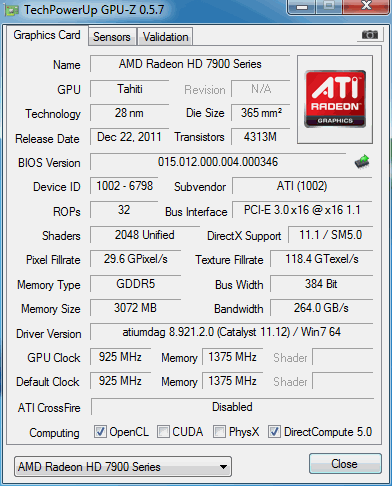
On the clock speed side of things, the core has gone from 880MHz to 925MHz while the memory carries the same 5500MHz QDR clock. The big change in the memory not only comes in with the move to 3GB from 2GB, but also a wider memory bus that is now 384-bit verse 256-bit. Overall we've also seen a big boost in the transistor count moving to 4.31B from 2.64B.
Outside of improvements in the general core architecture, we find AMD promoting a few other key areas including Eyefinity 2.0 which brings with it Discrete Digital Multi-Point Audio which translates into each output in a multi output scenario is able to have its own independent stream, something handy for multi person video conferencing. Support for 4k resolution is also available and just a general uniting of AMD Eyefinity, HD3D and CrossFire is all bought together to work in harmony.
App acceleration has also been improved with the latest generation of UVD supporting more video formats making the encode process not only better than before, but also faster. Along with hardware acceleration for the encoding side of things, we've got hardware acceleration for Chrome, Flash, Silverlight, PowerPoint and Google Earth to name just a few of the programs. The HD 7970 is ultimately not only designed for people who want to play faster, but for those who want to work faster.
Benchmarks - Test System Setup
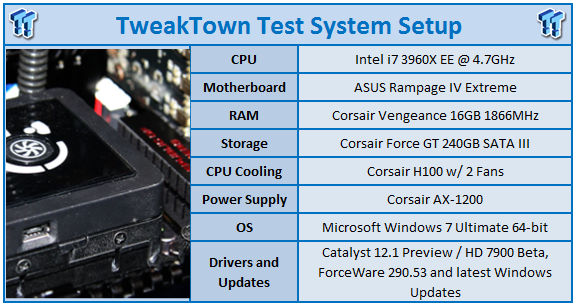
We would like to thank the following companies for supplying and supporting us with our test system hardware and equipment: Intel, ASUS and Corsair.
When looking at the HD 7970 we want to ultimately see how it compares against three cards on the market at the moment. The first is of course the HD 6970, we want to see just want kind of performance increase we get over the previous generation card from AMD.
The second card is of course the GTX 580, the faster single GPU card in the GTX 580 vs. HD 6970 war that has been going on for months. We don't doubt for a second that AMD are going to beat it, but the question is by how much and is it enough for us to upgrade to a HD 7970 if we're a current GTX 580 user.
The final card, and probably a little bit of a weird one is the HD 6990. Sure it's a dual GPU card and the chances are the HD 7970 is going to lag behind it in every instance because we know that the HD 7970 isn't 90% - 100% faster than the HD 6970. None the less, though, it's going to be interesting to see what the performance is like of the dual GPU beast from AMD against its new single GPU beast.
Along with those cards we've also got a GTX 570 and GTX 560 Ti 448 included in our graphs today, the main cards we'll be looking at, though, are no doubt going to be the three above. On the benchmarking side of things we'll start off with some synthetic benchmarks like 3DMark 11 and Heaven before we move into our real world games which include a spread of game engines and emphasis on different technologies. Something we'll be looking closely at today is the improvements AMD have made in tessellation, and that is going to be seen best in Heaven and Lost Planet 2.
Let's get started!
The FPS Numbers Explained
When we benchmark our video cards and look at the graphs, we aim to get to a certain level of FPS which we consider playable. While many may argue that the human eye can't see over 24 FPS or 30 FPS, any true gamer will tell you that as we climb higher in Frames Per Seconds (FPS), the overall gameplay feels smoother. There are three numbers we're looking out for when it comes to our benchmarks.
30 FPS - It's the minimum number we aim for when it comes to games. If you're not dropping below 30 FPS during games, you're going to have a nice and smooth gaming experience. The ideal situation is that even in a heavy fire fight, the minimum stays above 30 FPS making sure that you can continue to aim easily or turn the corner with no dramas.
60 FPS - It's the average we look for when we don't have a minimum coming at us. If we're getting an average of 60 FPS, we should have a minimum of 30 FPS or better and as mentioned above, it means we've got some smooth game play happening.
120 FPS - The new number that we've been hunting down over recent months. If you're the owner of a 120 Hz monitor, to get the most out of it you want to get around the 120 FPS mark. Moving from 60 FPS / 60 Hz to 120 FPS / 120 Hz brings with it a certain fluidity that can't really be explained, but instead has to be experienced. Of course, if you're buying a 120 Hz monitor to take advantage of 3D, an average of 120 FPS in our benchmark means that in 3D you will have an average of 60 FPS, which again means you should expect some smooth gameplay.
Benchmarks - 3DMark 11
3DMark 11
Version and / or Patch Used: 1.1
Developer Homepage: http://www.futuremark.com
Product Homepage: http://www.3dmark.com/3dmark11/
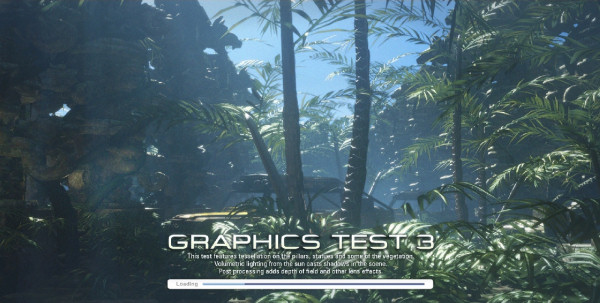
3DMark 11 is the latest version of the world's most popular benchmark. Designed to measure your PC's gaming performance 3DMark 11 makes extensive use of all the new features in DirectX 11 including tessellation, compute shaders and multi-threading. Trusted by gamers worldwide to give accurate and unbiased results, 3DMark 11 is the best way to consistently and reliably test DirectX 11 under game-like loads.
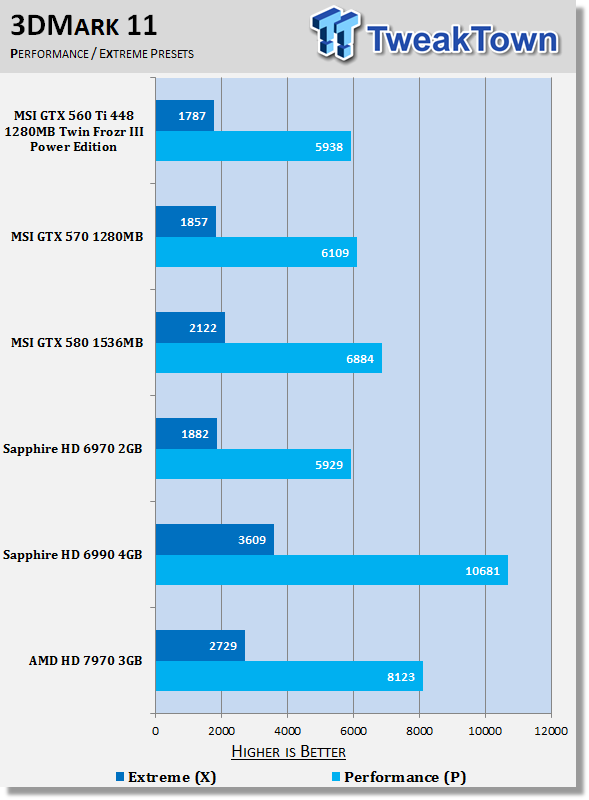
Straight away we can see the new HD 7970 separate itself from the pack of single GPU cards with massive gains over the HD 6970 in both the P and X preset and exceptional performance when compared to the GTX 580.
Even compared to the dual GPU beast that is the HD 6990, we can see that the HD 7970s performance is exceptionally strong against it. Let's just hope that this translates outside of 3DMark 11.
Benchmarks - Unigine Heaven Benchmark
Unigine Heaven Benchmark
Version and / or Patch Used: 2.5
Developer Homepage: http://www.unigine.com
Product Homepage: http://unigine.com/press-releases/091022-heaven_benchmark//
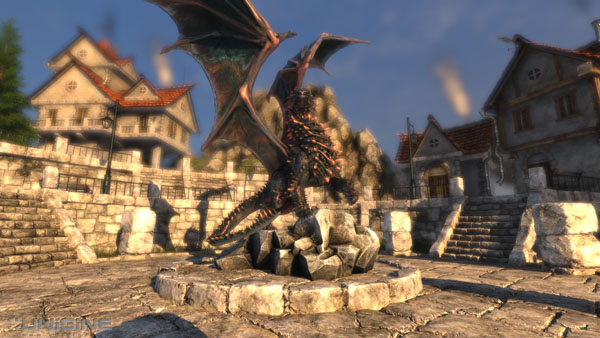
New benchmark grants the power to unleash the DirectX 11 potential in the gift wrapping of impressively towering graphics capabilities. It reveals the enchanting magic of floating islands with a tiny village hidden in the cloudy skies. With the interactive mode emerging experience of exploring the intricate world is ensured within reach. Through its advanced renderer, Unigine is one of the first to set precedence in showcasing the art assets with tessellation, bringing compelling visual finesse, utilizing the technology to the full extend and exhibiting the possibilities of enriching 3D gaming.
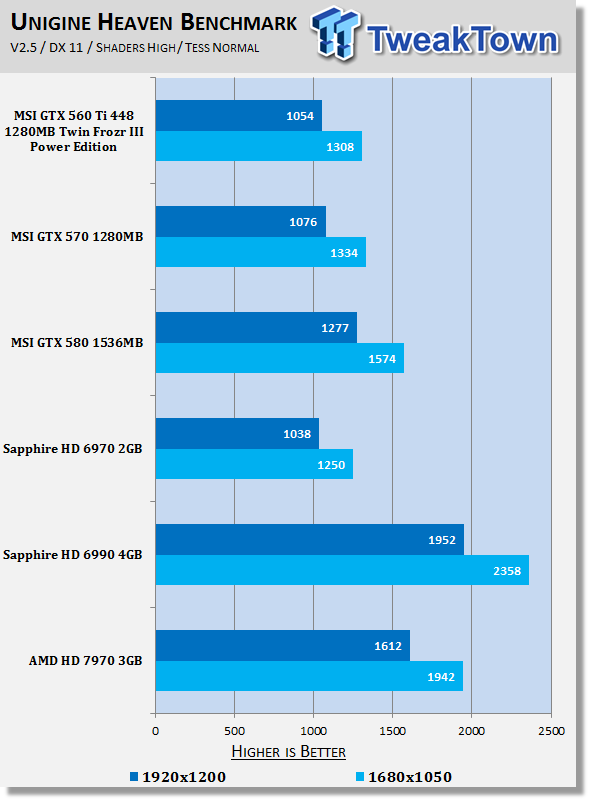
Tessellation is an area that NVIDIA have always been strong in, AMD have done a good job of improving performance in this area as we move from generation to generation and looking above we can see they've again done an excellent job making improvements in this area.
Comparing the HD 6970 and HD 7970 we can see gains of up to 60% at the higher resolution. Even against the GTX 580, a card that has always done excellent under tessellation heavy benchmarks, the HD 7970 offers extremely strong performance.
Benchmarks - Tom Clancy's H.A.W.X. 2
Tom Clancy's H.A.W.X.2
Version and / or Patch Used: Benchmark Demo
Timedemo or Level Used: Built-in Test
Developer Homepage: http://www.ubi.com/UK/default.aspx
Product Homepage: http://www.hawxgame.com/
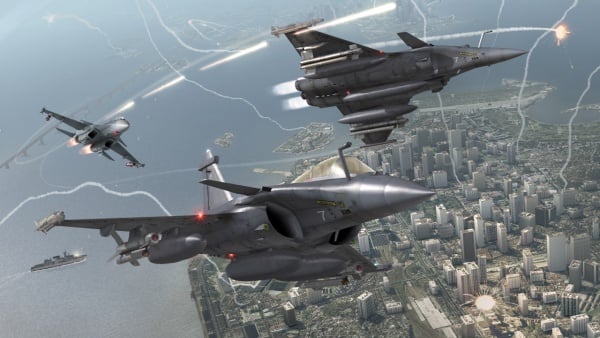
Tom Clancy's H.A.W.X. 2 is an arcade-style flight action game developed by Ubisoft Romania and published by Ubisoft. The game is the sequel to Tom Clancy's H.A.W.X., released in 2009.
The game begins with Colonel David Crenshaw participating in a routine patrol mission in the Middle East. After halting an insurgent attack, a volley of missiles is fired at the Air Force base that Crenshaw was stationed at, with one of the missiles disabling Crenshaw's aircraft, resulting Crenshaw being in enemy captivity. A joint strike force composed of the U.S. Navy, U.S. Air Force, and a Ghost Recon squad executes an operation to rescue Crenshaw. In Scotland, Royal Navy Pilot Colin Munro encounters an unidentified passenger aircraft that explodes from an on-board bomb when undergoing training exercise. In Russia, an air force squadron led by Colonel Denisov and Captain Dmitri Sokov engages separatist aircraft but is ordered to retreat from the region after numerous Russian military installations have been attacked.
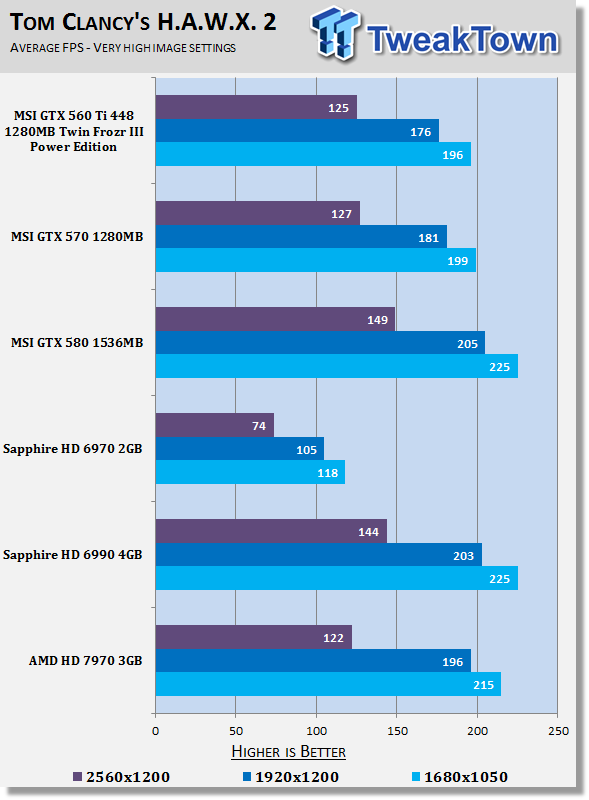
Single GPU offerings from AMD have never done well under H.A.W.X. 2, it's just always been one of those games that hasn't been able to take full advantage of what's on offer from an AMD card. You can see that changes with the release of the HD 7970, though, with some excellent performance that puts it similar to that of the HD 6990.
Overall we do see it sits just a little behind the GTX 580 still, but no longer are we running at half the performance. This is good news for anyone on an AMD card and has gone down the path of a 120Hz screen and wants those big numbers.
Benchmarks - Mafia II
Mafia II
Version and / or Patch Used: Latest Steam Update
Timedemo or Level Used: Built in Benchmark
Developer Homepage: http://www.2kczech.com/
Product Homepage: http://www.mafia2game.com/
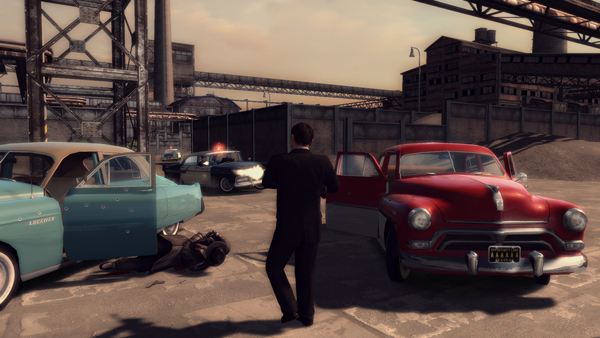
Mafia II is a third-person action-adventure video game, the sequel to Mafia: The City of Lost Heaven. It is developed by 2K Czech, previously known as Illusion Softworks, and is published by 2K Games. The game is set from 1943 to 1951 in Empire Bay (the name is a reference to New York's state nickname "The Empire State"), a fictional city based on San Francisco and New York City, with influences from Chicago and Detroit. The game features a completely open-ended game map of 10 square miles. No restrictions are included from the start of the game. There are around 50 vehicles in the game, as well as licensed music from the era.
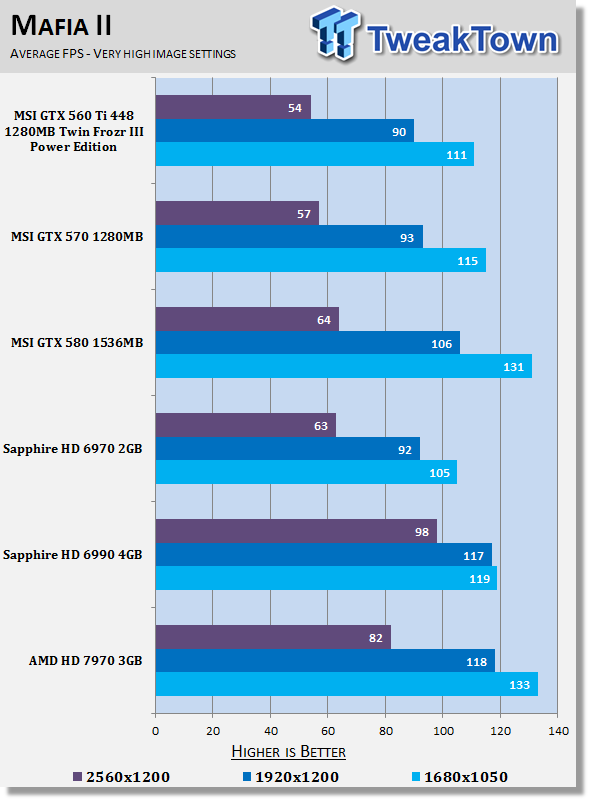
I always brought up my concern with AMD in regards to Mafia II, performance was good, but it always seemed to hit this wall at about the 120 FPS mark. You can see here for the first time we see an AMD break past that 120 FPS mark, because of this we can see performance sits a bit stronger then the HD 6990 at 1680 x 1050 and 1920 x 1200.
At 2560 x 1600 we can see it falls behind the HD 6990 finally, but compared to the other single GPU offerings, we've got some very good performance on display here. While the HD 6970 and GTX 580 manage to just scrape in over 60 FPS, the HD 7970 manages to offer a huge 82 FPS making sure we've got silky smooth gameplay.
Benchmarks - Lost Planet 2
Lost Planet 2
Version and / or Patch Used: Benchmark Demo
Timedemo or Level Used: Built in Benchmark - Test A Scene 1
Developer Homepage: http://www.capcom.com/
Product Homepage: http://www.lostplanet2game.com/
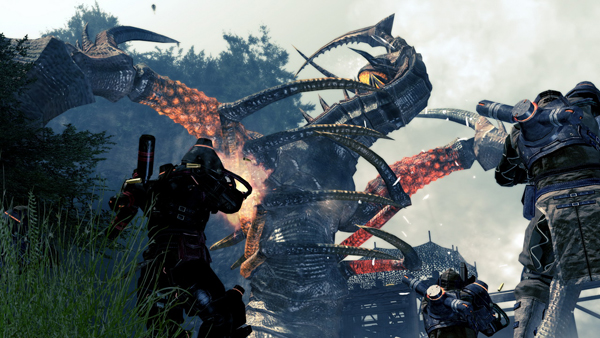
Lost Planet 2 is a third-person shooter video game developed and published by Capcom. The game is the sequel to Lost Planet: Extreme Condition which is also made by Capcom, taking place ten years after the events of the first game, on the same fictional planet. The story takes place back on E.D.N. III 10 years after the events of the first game. The snow has melted to reveal jungles and more tropical areas that have taken the place of more frozen regions. The plot begins with Mercenaries fighting against Jungle Pirates. After destroying a mine, the Mercenaries continue on to evacuate the area, in which a Category-G Akrid appears and attacks them. After being rescued, they find out their evacuation point (Where the Category-G appeared) was a set-up and no pick up team awaited them. The last words imply possible DLC additions to the game, "There's nothing to be gained by wiping out snow pirates... unless you had some kind of grudge."
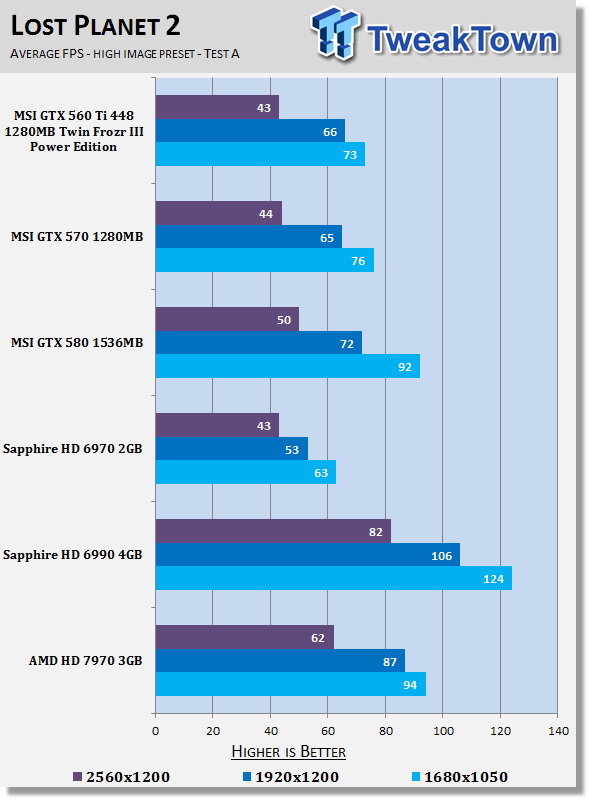
Lost Planet 2 is a great benchmark due to the sheer intensity of the game. Out of the box we continue to see no single GPU offering break that 60 FPS mark we aim for at 2560 x 1600, the HD 6970 sits 17 FPS away from it while the GTX 580 sits 10 FPS away. Another test that relies heavily on tessellation, though, sees excellent performance come out of the HD 7970 with the card breaking that 60 FPS barrier that we always aim for.
Outside of 2560 x 1600, we see unlike the HD 6970, the new HD 7970 has absolutely no issue dealing with the game at both 1680 x 1050 and 1920 x 1200 as well. Compared to the GTX 580, we see that 1680 x 1050 performance is similar, as we increase the resolution, though, we see the HD 7970 separate itself receiving more and more FPS.
Benchmarks - Aliens vs. Predator
Aliens vs. Predator
Version and / or Patch Used: Standalone Benchmark
Timedemo or Level Used: Built in Benchmark
Developer Homepage: http://www.rebellion.co.uk/
Product Homepage: http://www.sega.com/games/aliens-vs-predator/
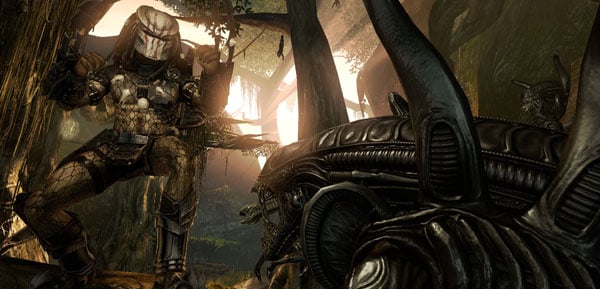
Aliens vs. Predator is a science fiction first-person shooter video game, developed by Rebellion Developments, the team behind the 1999 original PC game, and published by Sega for Microsoft Windows, the PlayStation 3 and the Xbox 360. The game is based on the Alien vs. Predator franchise, a combination of the characters and creatures of the Alien franchise and the Predator franchise. There are three campaigns in the game, one for each race/faction (the Predators, the Aliens and the Colonial Marines), that, while separate in terms of individual plot and gameplay, form one overarching storyline.
Following the storyline of the campaign modes comes the multiplayer aspect of the game. In this Multiplayer section of the game, players face off in various different gametypes in various different ways.
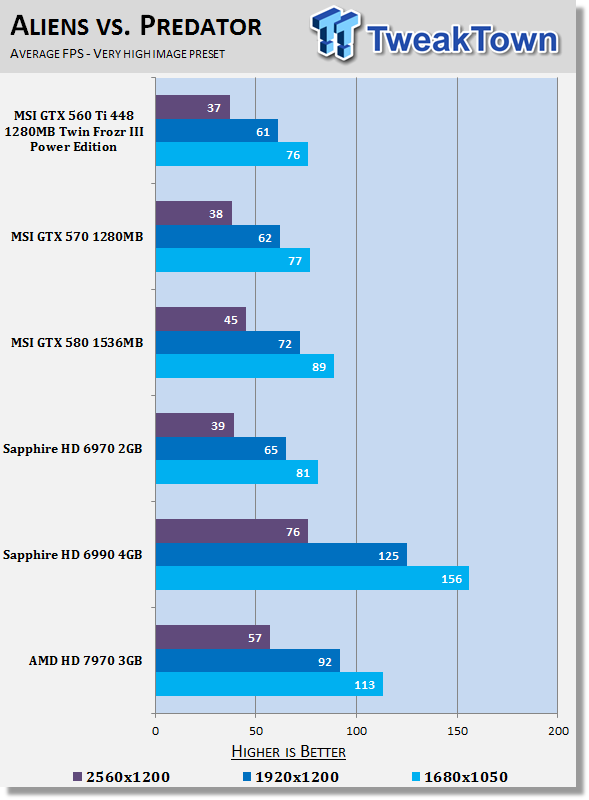
Aliens vs. Predator is another one of those super intensive games and you can see even the new HD 7970 struggles to hit that 60 FPS mark at 2560 x 1600 with it falling just 3 FPS behind. Across the board we see some excellent gains, though, and the card does a fantastic job of separating itself from the other single GPU offerings.
Benchmarks - Just Cause 2
Just Cause 2
Version and / or Patch Used: 1.0.0.2
Timedemo or Level Used: Dark Tower
Developer Homepage: http://www.eidos.com/
Product Homepage: http://www.justcause.com/
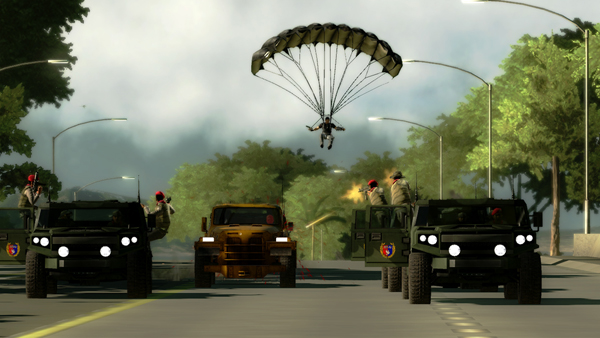
Just Cause 2 employs the Avalanche Engine 2.0, an updated version of the engine used in Just Cause. The game is set on the other side of the world from the original Just Cause, on the fictional island of Panau in Southeast Asia. Panau has varied terrain, from desert to alpine to rainforest. Rico Rodriguez returns as the protagonist, aiming to overthrow the evil dictator Pandak "Baby" Panay and confront his former mentor, Tom Sheldon.
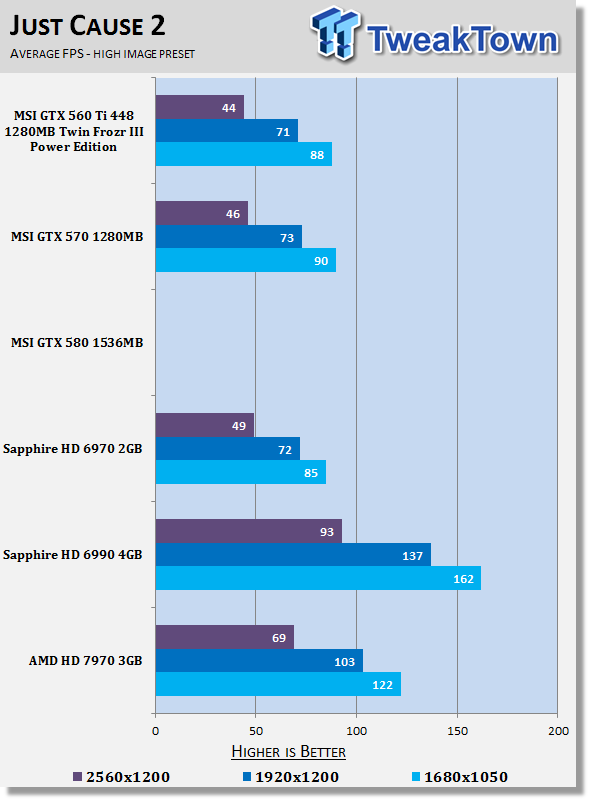
Looking at Just Cause 2, this is the exact kind of thing we want to see when buying a new card. Looking at 2560 x 1600 we can see the HD 6970 struggles to give us a playable frame rate coming in at 49 FPS. The HD 7970 on the other hand gives us an average of 69 FPS, when we can move from an unplayable number to a playable one, we consider this a big win. Especially when you don't have to do any overclocking, it's simply a true upgrade that gives a good boost in performance that will make a real difference.
Unfortunately we can't compare to the GTX 580 for the simple reason Just Cause 2 didn't want to load up. We even deleted it and re-downloaded it to no success. Pulling out the GTX 580 and putting in the HD 6990 after, though, and the game fired straight up on the AMD offering. It could indeed be an issue with the most recent beta driver from NVIDIA. We'll be investigating it more.
Benchmarks - Metro 2033
Metro 2033
Version and / or Patch Used: Latest Steam Update
Timedemo or Level Used: Built in Benchmark
Developer Homepage: http://www.4a-games.com/
Product Homepage: http://www.thqnordic.com/
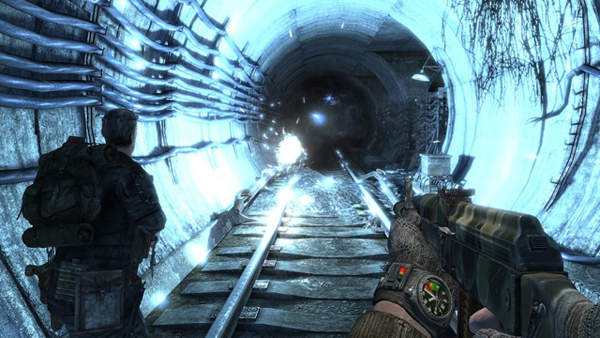
Metro 2033 is an action-oriented video game with a combination of survival horror and first-person shooter elements. The game is based on the novel Metro 2033 by Russian author Dmitry Glukhovsky. It was developed by 4A Games in Ukraine and released in March 2010 for Microsoft Windows and Xbox 360.[3] In March 2006, 4A Games announced a partnership with Glukhovsky to collaborate on the game.[4] The game was announced at the 2009 Games Convention in Leipzig;[5] a first trailer came along with the announcement.[6] A sequel was announced, currently titled Metro: Last Light.
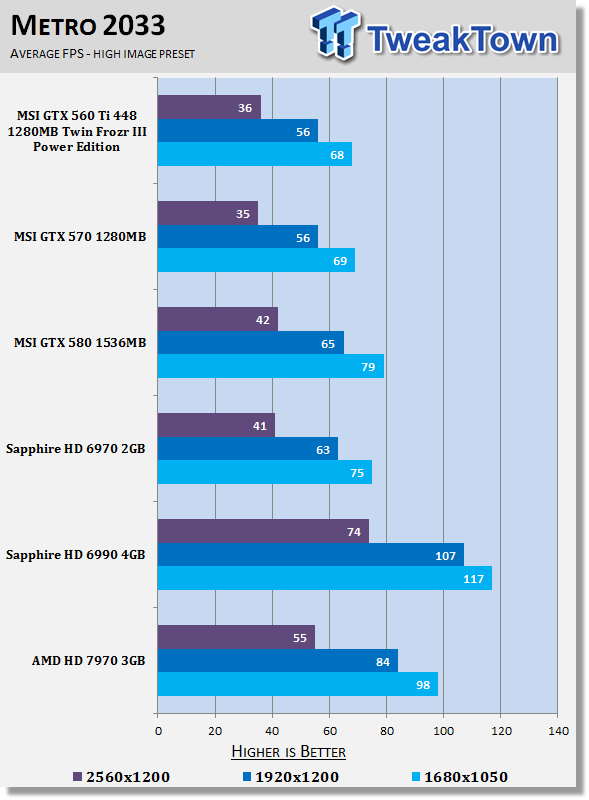
Metro 2033 is just another one of those super intensive games that again places a lot of pressure on GPUs thanks to its next generation features. While the game itself isn't anything to get all that excited about, a bit like the Crysis series, the technology implemented within the game make it an excellent benchmark.
While we do again see like Aliens vs. Predator the 2560 x 1600 number falls just below that 60 FPS average we like to see, across the board we've got some serious improvements when compared to the HD 6970 and GTX 580.
Benchmarks - Dirt 3
Dirt 3
Version and / or Patch Used: Latest Steam Update
Timedemo or Level Used: Built in Benchmark
Developer Homepage: http://www.codemasters.com/
Product Homepage: http://www.dirt3game.com/
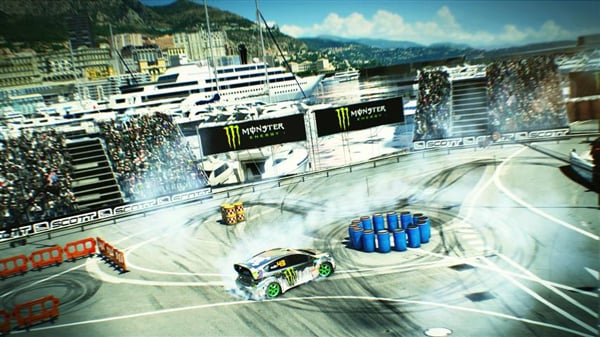
DiRT 3 boasts more cars, more locations, more routes and more events than any other game in the series, including over 50 rally cars representing the very best from five decades of the sport. With more than double the track content of 2009's hit, DiRT 3 will see players start at the top as a professional driver, with a top-flight career in competitive off-road racing complimented by the opportunity to express themselves in Gymkhana-style showpiece driving events.
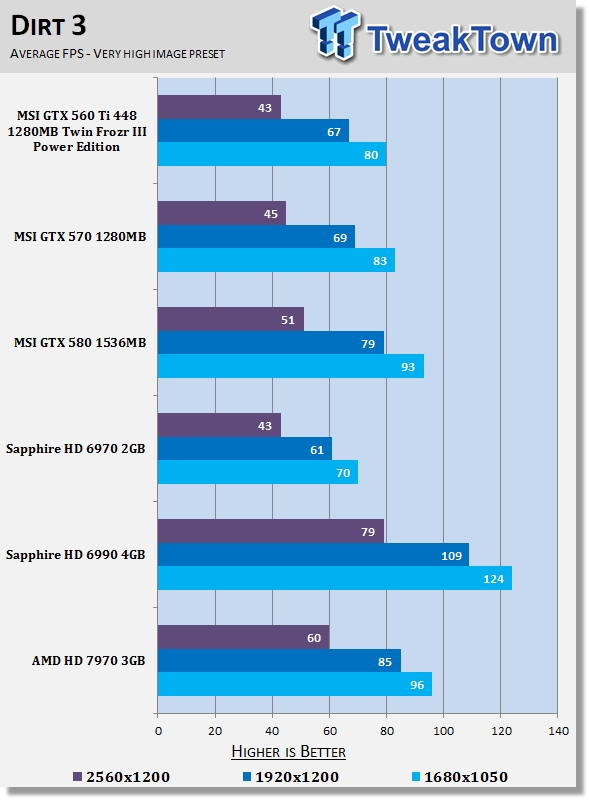
Dirt 3 paints a similar picture to what we saw under Just Cause 2 with our 2560 x 1600 numbers on the HD 6970 and in this case the GTX 580 coming in below that 60 FPS mark. Move over to the HD 7970 and we can see we manage to break into that 60 FPS realm we aim for, even if it's just at an even 60 FPS.
We again see ourselves with this upgrade moving from an unplayable setup to a playable one. If you found yourself with a HD 6970 and you wanted to play smoothly at a native resolution of 2560 x 1440 / 1600, you'd find that you had to turn detail down a bit to lift the numbers. It's good to know that you could install the HD 7970, go into the graphics card options and turn up all those in game details, and still continue to get the smooth FPS you had before, but now with the game looking better than ever.
Benchmarks - Far Cry 2
Far Cry 2
Version and / or Patch Used: 1.01
Timedemo or Level Used: Ranch Long
Developer Homepage: http://www.ubi.com/
Product Homepage: http://www.farcry2.com/
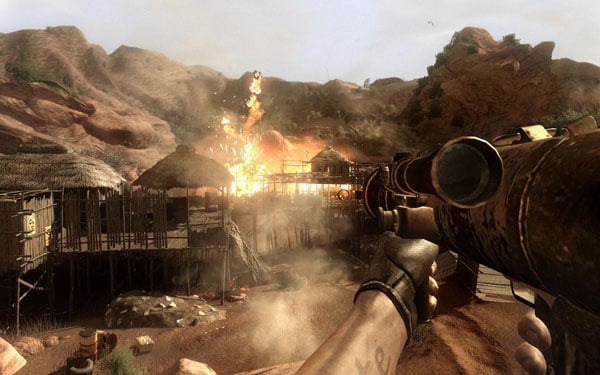
The Dunia Engine was built specifically for Far Cry 2 by the award-winning Ubisoft Montreal development team. It delivers the most realistic destructible environments, amazing special effects such as dynamic fire propagation and storm effects, real-time night-and-day cycle, dynamic music system, non-scripted enemy A.I. and so much more.
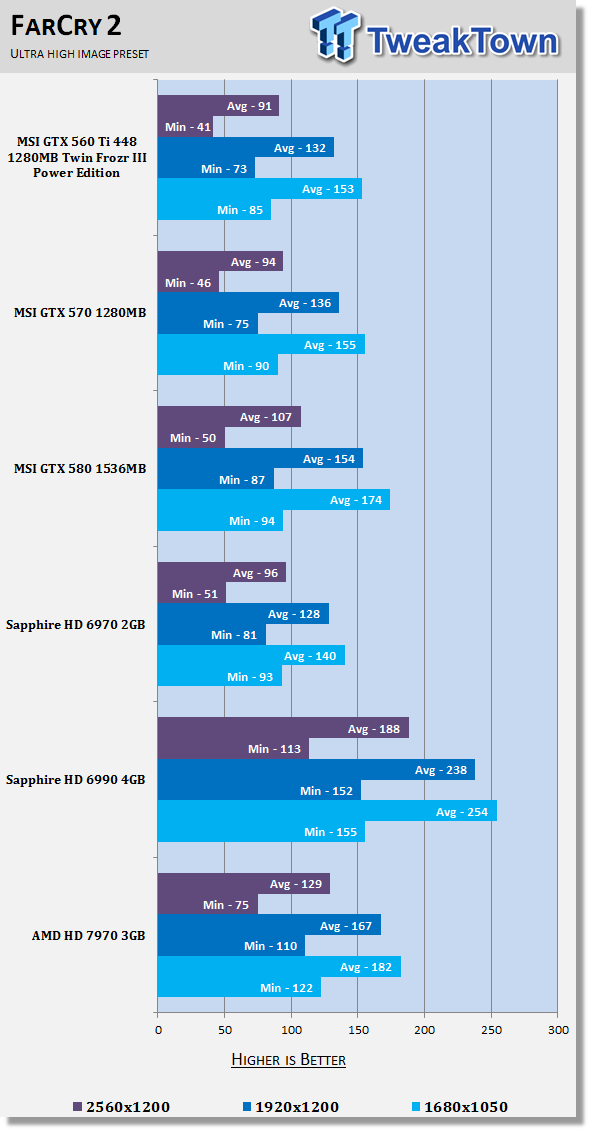
We see great FPS out of FarCry 2 and for the most part we don't really see high-end cards struggle under the game. The consistency of the benchmark combined with the intensity when we turn on AA and AF continue to make it an excellent tool. You can see here compared to the HD 6970 and GTX 580, we move from a 50 FPS minimum to a 75 FPS minimum, a gain that equates to an extra 50% in performance.
This is really what we've seen all along with the new HD 7970, gains ranging from 40% - 60%. These are some impressive gains for a card that comes in at the same size as the HD 6970.
Benchmarks - High Quality AA and AF
High Quality AA and AF
Our high quality tests let us separate the men from the boys and the ladies from the girls. If the cards weren't struggling before they will start to now.
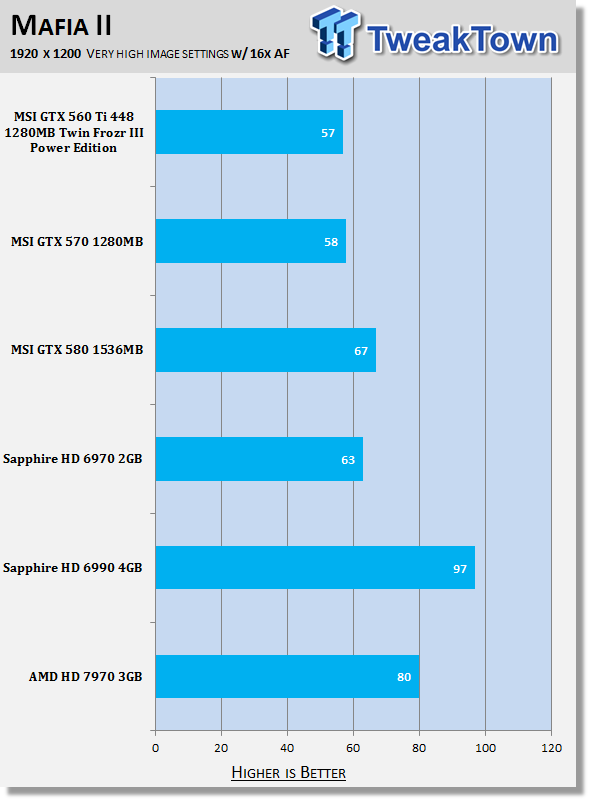
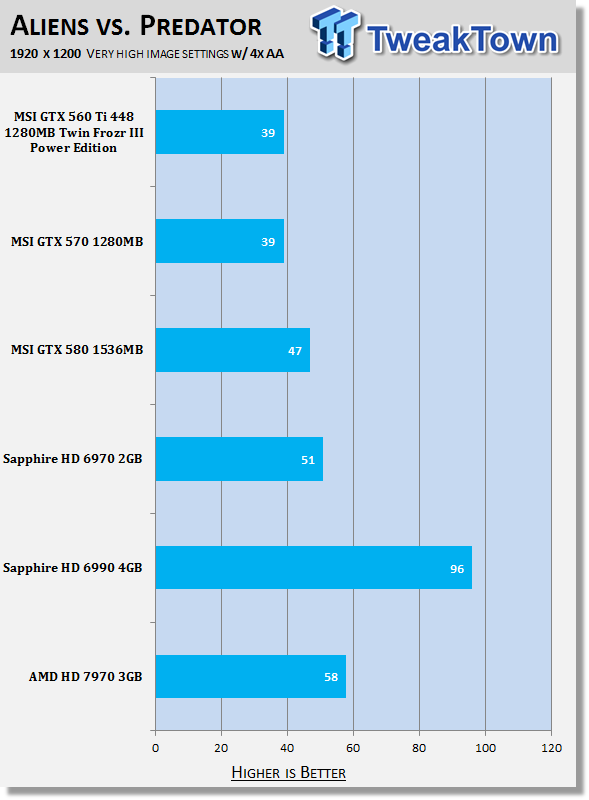
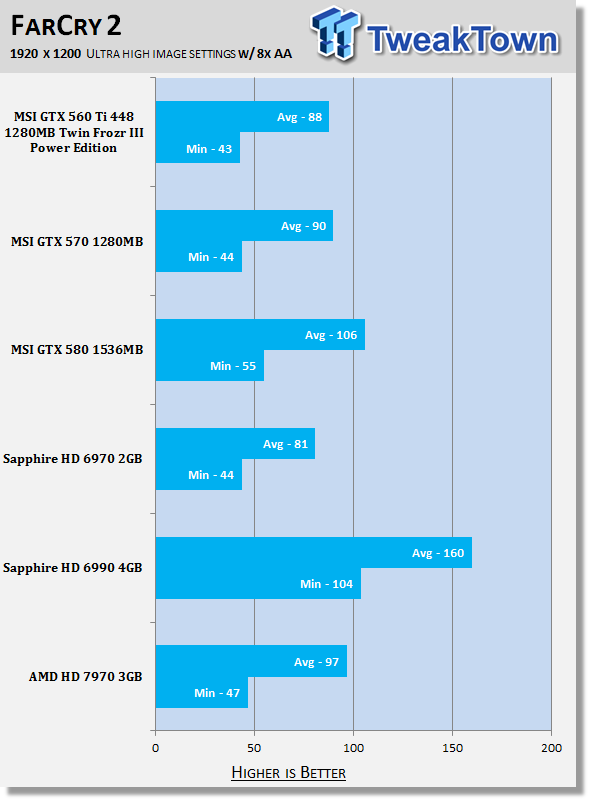
When we turn on AA and AF we continue to see that very strong performance on offer. Mafia II sees some good breathing room with our average moving out to 80 FPS, Aliens vs. Predator also sees some nice gains, unfortunately the 58 FPS average is just shy of that 60 FPS number we aim for. FarCry 2 AA performance is also very good, but the gains that were present in the non AA tests aren't seen here.
Temperature Test

The temperature of the core is pulled from MSI Afterburner with the max reading used after a completed run off 3DMark Vantage and the Performance preset.
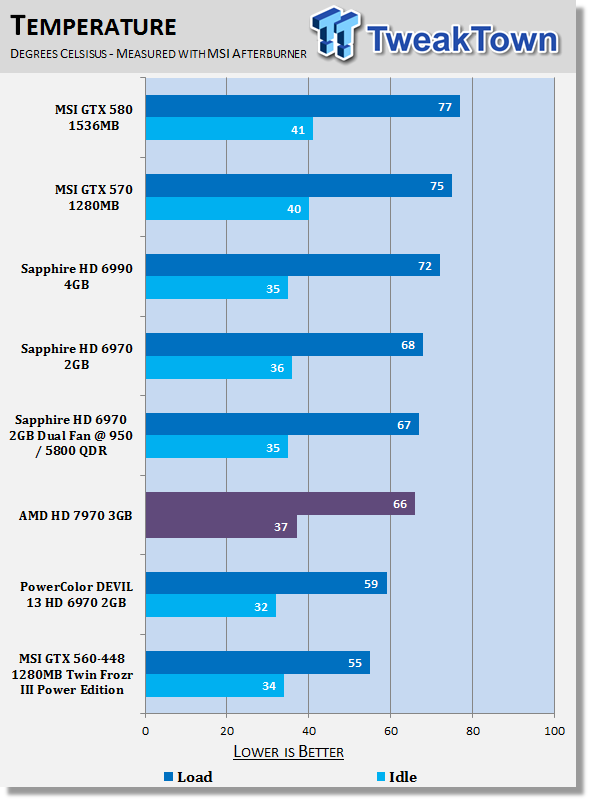
Firing up MSI Afterburner and looking at the core temperature, I find myself surprised with the low numbers. We come in a nice chunk below the GTX 580 offering and sit at a similar level to the HD 6970.
Considering the gains we're seeing, the fact that the card is ultimately running no hotter than the previous generation HD 6970 is just fantastic news.
Sound Test

Pulling out the TES 1350A Sound Level Meter we find ourselves quickly yelling into the top of it to see how loud we can be.
After five minutes of that we get a bit more serious and place the device two CM away from the fan on the card to find the maximum noise level of the card when idle (2D mode) and in load (3D mode).
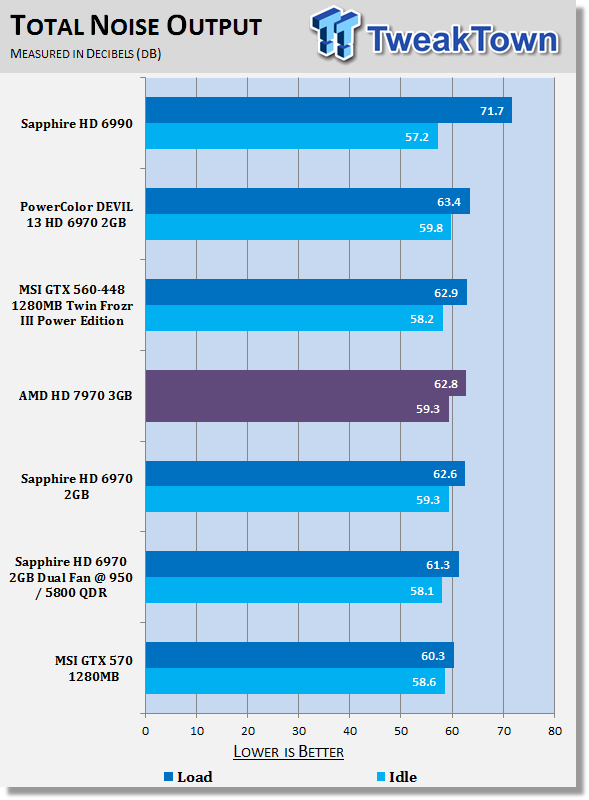
For the most part we see the new 7970 lines up pretty evenly with our other single GPU offerings. It's really no louder, nor quieter than them. Of course the HD 6990 as always stands out and it's probably something that's going to cause you to lean towards the single GPU offerings.
Power Consumption Tests

Using our new PROVA Power Analyzer WM-01 or "Power Thingy" as it has become quickly known as to our readers, we are now able to find out what kind of power is being used by our test system and the associated graphics cards installed. Keep in mind; it tests the complete system (minus LCD monitor, which is plugged directly into AC wall socket).
There are a few important notes to remember though; while our maximum power is taken in 3DMark06 at the same exact point, we have seen in particular tests the power being drawn as much as 10% more. We test at the exact same stage every time; therefore tests should be very consistent and accurate.
The other thing to remember is that our test system is bare minimum - only a SSD hard drive is used with a single CD ROM and minimal cooling fans.
So while the system might draw 400 watts in our test system, placing it into your own PC with a number of other items, the draw is going to be higher.
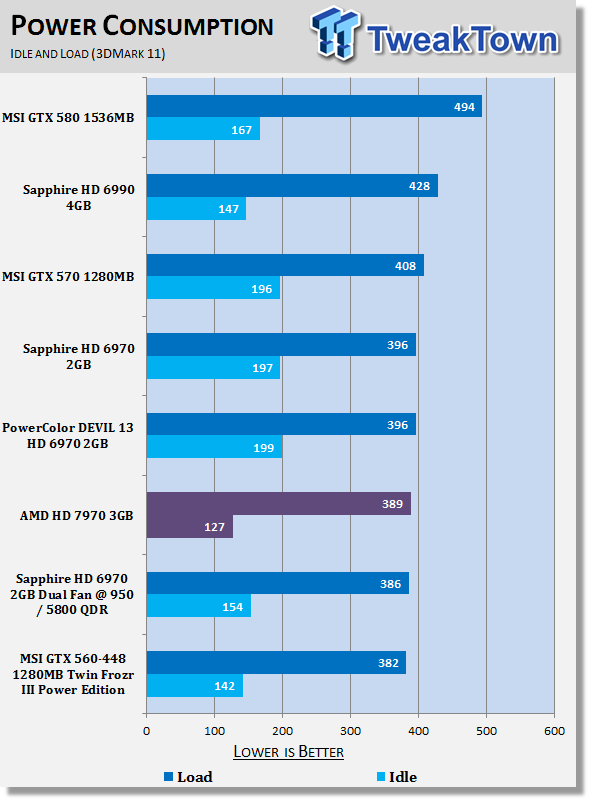
Power draw is something that AMD are promoting and the idle power draw is just crazy with it coming in a good chunk lower than everything else we've got here.
On the load front, we can see it again lines up around the HD 6970 area. Considering the gains we see over the HD 6970, this is really a very strong number we're seeing out of AMD and it's clear a lot of work has been done here.
Final Thoughts
With the last generation of video cards from AMD and NVIDIA, a lot of people felt a bit hard done by. Sure, the GTX 480 to GTX 580 and HD 5970 to HD 6970 brought with it some nice performance gains, but there wasn't the technological leap that we would've liked to have seen. The move to a 28nm manufacturing process and a whole bunch of new optimizations from AMD, though, this time, bring a proper next generation card verse the refresh we saw out of the last generation cards.
It would've been nice to say that the new HD 7k series card from AMD is the fastest card on the market, but the lack of a dual GPU option means that the HD 6990 continues to be the fastest card on the market. That means we move over to the whole "Fastest Single GPU" line of thought which is one that bugged me during the GTX 480 era. None the less, the HD 7970 is indeed the fastest single GPU offering on the market at the moment, a title that AMD hasn't really held for a while. Fortunately for them, though, they now have the fastest card on the market and the fastest single GPU card on the market.
It's a pity that AMD can't see the same success on the CPU side of things. For the last few months they've been a bit back and forth with NVIDIA when it comes to being the better option. The lead they're going to take over NVIDIA in the coming months should see them be the clear winner for at least a few months after that as we see a new dual GPU offering come from them and the mid-range segment get filled out with new models in the coming months.
The biggest issue with the HD 7970 doesn't have anything to do with the product itself, but simply the way AMD chose to handle the launch of this item. Launching so close to Christmas in itself is just terrible, but for it to be a pure paper launch makes it so much worse. I thought we'd left the days of paper launches, it's possible that the plan was to stop any last minute purchases on high-end NVIDIA offerings, though, and if you work your way through the results, you'd probably find yourself thinking, what's just a few more weeks.
The coming days we should see a flurry of retail samples hit and e-tail stores like Newegg will be stocking up. I do wonder, though, how close are we going to be to the $549 US launch price that AMD has set. To be completely honest I wouldn't be surprised if we see pricing sit closer to $599 US. $50 - $100 more than the GTX 580 is going to make it an easy purchase over it, though and that brings us to both the GTX 580 and NVIDIA.
We still seem to be a few months away from seeing a new high-end offering from NVIDIA, so what do they do in the mean time? No doubt they're not going to want to sacrifice all high-end purchases to AMD, the next step for them is going to be a price drop, the issue with that is you're going to have a cascade effect down to the mid-range offerings and we could find ourselves with a real price war on our hands. As good as the GTX 580 is, if you're able to get in to a HD 7970 for $50 - $100 US more, you'd be crazy not to.
The other interesting model is the HD 6990; ultimately still a faster card than the HD 7970. The issue is it's essentially discontinued almost. Stock is near impossible to find these days, this isn't a huge surprise, though, as we've seen the HD 6990 really struggle with supply since launch. Partners have always said they've never been able to get enough of them. People wanting a dual GPU option still have the GTX 590...but that's one model that has never got off the ground for NVIDIA. The fact that Newegg list only two and only one is available paints that picture pretty clearly.
The HD 7970 really has just come in and shaken everything up a bit and it's only for the better. We know about the performance, the problem is we don't really know about the price and availability. We know the price set by AMD, but leaked pricing from other parts of the world show it sitting much higher, stock is also a question as we hear of companies having pre sold their first and second batches.
Outside of the crappy timing, this is ultimately a good launch for AMD, and let's be honest, going back over the last few months they haven't had the smoothest time. The VGA team continues to do extremely well for the company and the fact they're going to be a good few months earlier than NVIDIA is only a good thing. What I can tell you, though, is that the next generation single GPU offering from NVIDIA is going to be faster. It's going to be faster because it has to be faster. I don't think that's going to be a shock to anyone, the cloud surrounding when we'll see it, though, is going to turn people off. Throw in the fact that AMD will have a good few months on them when it comes to sales means they're going to have room to move in price, considering that AMD is generally the cheaper option anyway, this is only good news for them.
Without some serious movement on the GTX 580 price, this is going to be the card to buy. Sure it's expensive at the MSRP $549 US price tag, but we'd expect no less out of a high-end part. As AMD fill out the HD 7k series of cards as well it's fairly safe to assume that they will gain more and more momentum in the coming months and expand market share. Combined with strong sales in the APU segment, at least two thirds of AMD business looks extremely strong. If only they could become a real contender in the high-end CPU market.
It's going to be easier for HD 6970 users to make the jump to the HD 7970, GTX 580 users on the other hand might prefer to hold off. HD 6990 users are either going to ignore it and wait for the HD 7990, or just go out and buy two of these come the 9th of January. Either way people are going to buy these cards and I think we'll see "out of stock" signs show up pretty quickly at popular e-tail sites over the next few weeks.

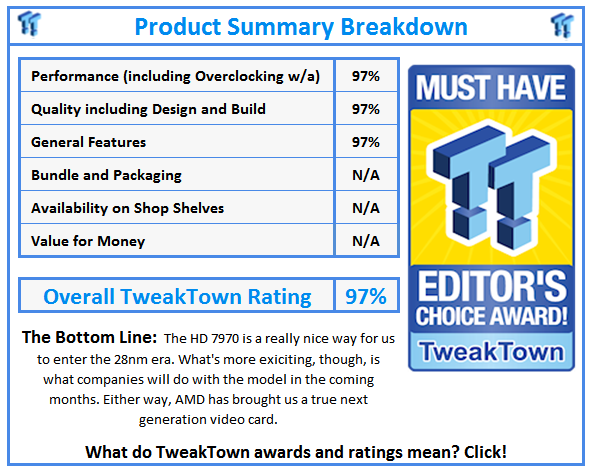
 United
States: Find other tech and computer products like this
over at
United
States: Find other tech and computer products like this
over at  United
Kingdom: Find other tech and computer products like this
over at
United
Kingdom: Find other tech and computer products like this
over at  Australia:
Find other tech and computer products like this over at
Australia:
Find other tech and computer products like this over at  Canada:
Find other tech and computer products like this over at
Canada:
Find other tech and computer products like this over at  Deutschland:
Finde andere Technik- und Computerprodukte wie dieses auf
Deutschland:
Finde andere Technik- und Computerprodukte wie dieses auf